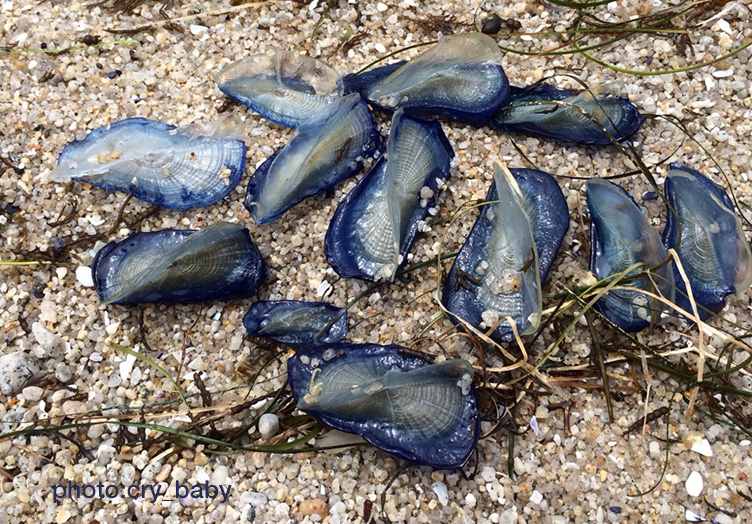Velella, the By-the-Wind Sailor
Click below to view the video of Velella velella in its natural habitat. 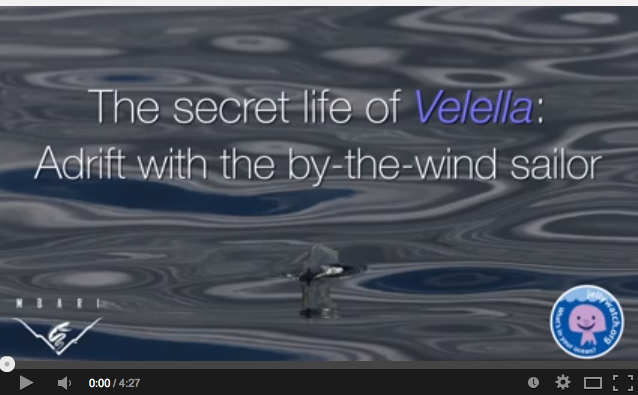
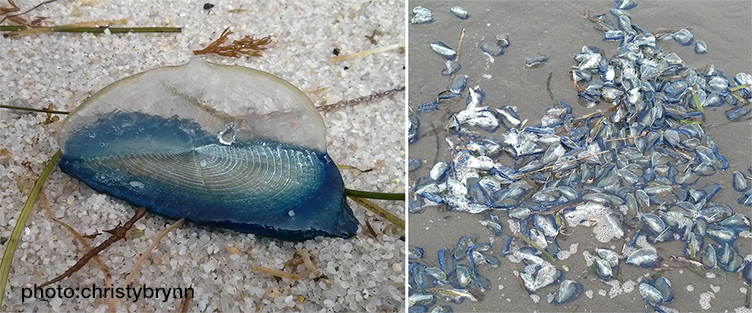 The genus Velella, known as the By-the-Wind sailor, and Porpita, known as blue-buttons (not to be confused with blue-bottles), are two interesting Hydrozoans (Cnidarians) that live at the surface of the water. Although they are blue-colored hydrozoans and float partly above the water like the Portuguese Man o' War (Physalia), they are not especially closely related to it or other siphonophores. Even recent literature called them siphonophores, but the nearest Cnidarian relatives are the "Capitate" hydroids.
The genus Velella, known as the By-the-Wind sailor, and Porpita, known as blue-buttons (not to be confused with blue-bottles), are two interesting Hydrozoans (Cnidarians) that live at the surface of the water. Although they are blue-colored hydrozoans and float partly above the water like the Portuguese Man o' War (Physalia), they are not especially closely related to it or other siphonophores. Even recent literature called them siphonophores, but the nearest Cnidarian relatives are the "Capitate" hydroids.  One of the most interesting things about Velella is that it is best described as a hydroid colony which has flipped itself over. It is unlike a traditional jellyfish (medusa), but rather like the benthic stage of a hydroid. Instead of living attached to rocks on the bottom, its "substrate" is the ocean's surface. These hydroid colonies bud off tiny medusae, little "jellyfish", just like many benthic hydroids do. The medusae live, feed, and reproduce in surface waters (Larson, 1980).
One of the most interesting things about Velella is that it is best described as a hydroid colony which has flipped itself over. It is unlike a traditional jellyfish (medusa), but rather like the benthic stage of a hydroid. Instead of living attached to rocks on the bottom, its "substrate" is the ocean's surface. These hydroid colonies bud off tiny medusae, little "jellyfish", just like many benthic hydroids do. The medusae live, feed, and reproduce in surface waters (Larson, 1980). 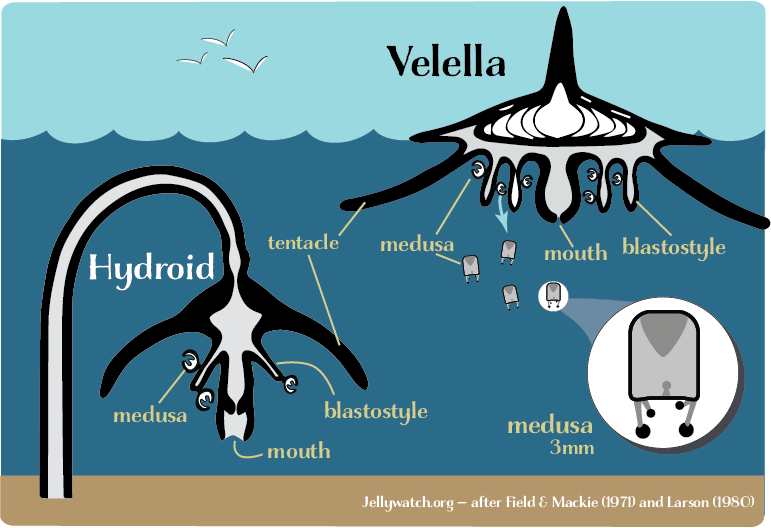 Velella typically live far offshore in open ocean waters, and their little sails help distribute them using the force of the wind. However because they sail only downwind or at a slight angle to the wind, they are often blown ashore in very high numbers, with millions piling onto beaches in drift rows.
Velella typically live far offshore in open ocean waters, and their little sails help distribute them using the force of the wind. However because they sail only downwind or at a slight angle to the wind, they are often blown ashore in very high numbers, with millions piling onto beaches in drift rows. 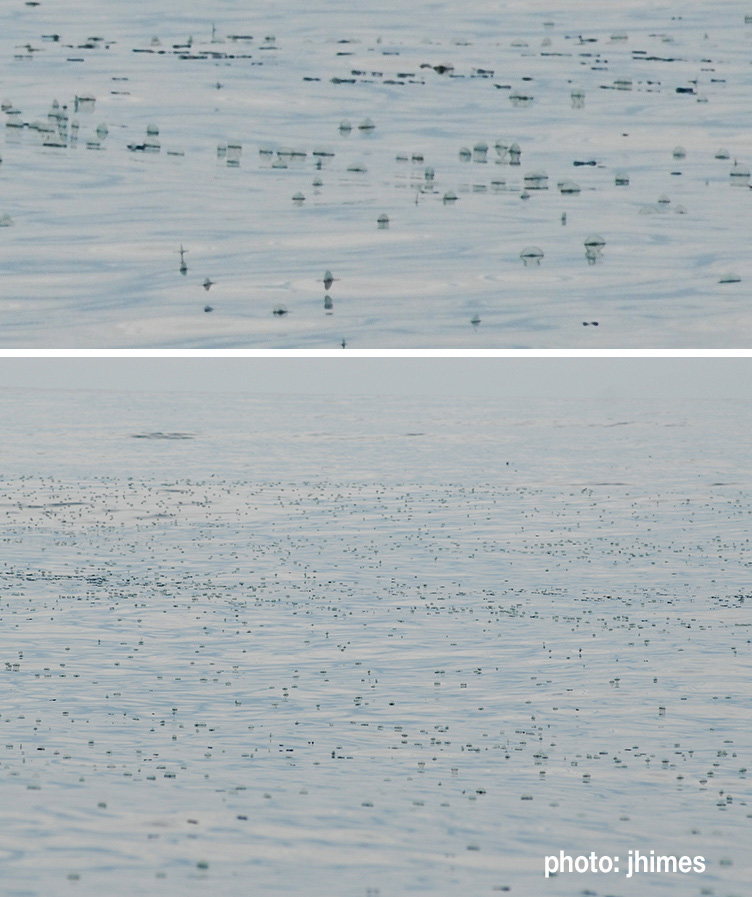
Recent Velella maps are found in these links. You can also get recent maps (updated hourly) for the West Coast of the US for 2014 and 2015 (high years) and for 2016. 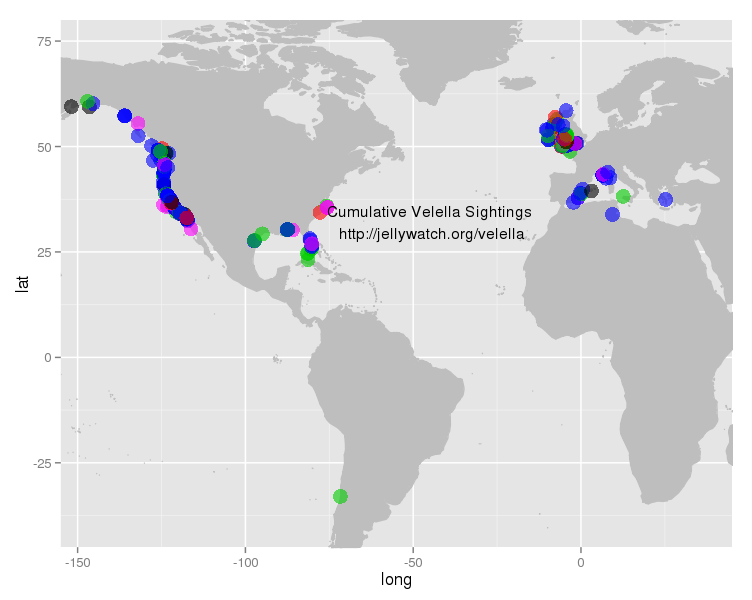 Besides their sail, a striking feature of Velella is their blue pigmentation. In fact, most animals that live on the surface of the water (Snails, jellies, fish) have blue pigmentation. It may serve different purposes for different organisms, but is like a combination of camouflage and protection from the suns rays. Dried animals on the beach lose their pigmentation and look bleached white.
Besides their sail, a striking feature of Velella is their blue pigmentation. In fact, most animals that live on the surface of the water (Snails, jellies, fish) have blue pigmentation. It may serve different purposes for different organisms, but is like a combination of camouflage and protection from the suns rays. Dried animals on the beach lose their pigmentation and look bleached white. 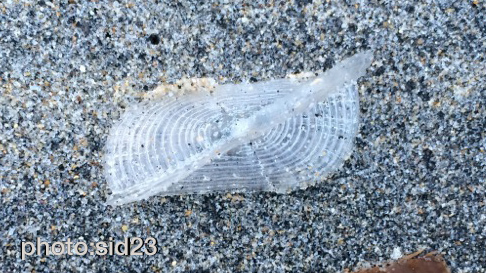 Velella are not dangerous to humans. They can sting and capture small prey, but they also harbor algal symbionts, giving mature specimens and greenish or even brown tint.
Velella are not dangerous to humans. They can sting and capture small prey, but they also harbor algal symbionts, giving mature specimens and greenish or even brown tint. 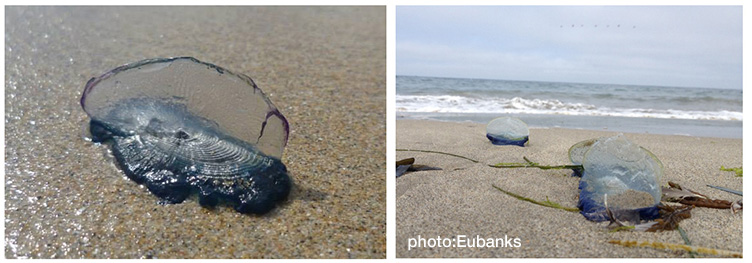 Most specimens are "left-handed" with the sail going from upper-left to lower-right along their long body axis, but a few are right-handed (Bieri, 1959). This dimorphism has led to speculation that there is a difference in preferred sailing direction in the northern and southern hemispheres, or on the eastern and western shores of oceans. So far these morphological differences have not been reliably correlated with patterns of geographic distribution or prevailing winds. To participate in a little experiment, count the number of left- or right-handed Velella and submit a sighting with the results in the description, or post a comment on our facebook page.
Most specimens are "left-handed" with the sail going from upper-left to lower-right along their long body axis, but a few are right-handed (Bieri, 1959). This dimorphism has led to speculation that there is a difference in preferred sailing direction in the northern and southern hemispheres, or on the eastern and western shores of oceans. So far these morphological differences have not been reliably correlated with patterns of geographic distribution or prevailing winds. To participate in a little experiment, count the number of left- or right-handed Velella and submit a sighting with the results in the description, or post a comment on our facebook page. 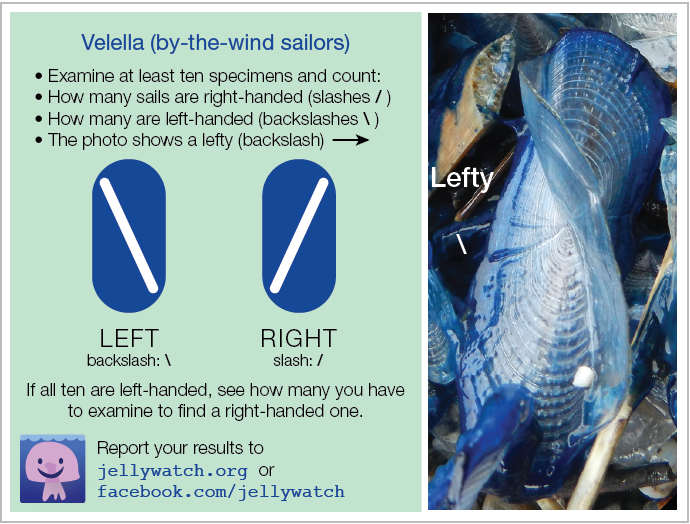 Further reading Bieri, R. (1959). Dimorphism and size distribution in Velella and Physalia. Nature, 184, 1333–1334. Fields, W. G., & Mackie, G. O. (1971). Evolution of the Chondrophora: Evidence from Behavioural Studies on Velella. Journal of the Fisheries Research Board of Canada, 28(10), 1595–1602. doi:10.1139/f71-238 Francis, L. (1991). Sailing downwind: aerodynamic performance of the Velella sail, J. Experimental Biol. 158(1), 117. Larson, R. J. (1980). The medusa of Velella velella (Linnaeus, 1758)(Hydrozoa, Chondrophorae). J. Plankton Research, 2, 183–186.
Further reading Bieri, R. (1959). Dimorphism and size distribution in Velella and Physalia. Nature, 184, 1333–1334. Fields, W. G., & Mackie, G. O. (1971). Evolution of the Chondrophora: Evidence from Behavioural Studies on Velella. Journal of the Fisheries Research Board of Canada, 28(10), 1595–1602. doi:10.1139/f71-238 Francis, L. (1991). Sailing downwind: aerodynamic performance of the Velella sail, J. Experimental Biol. 158(1), 117. Larson, R. J. (1980). The medusa of Velella velella (Linnaeus, 1758)(Hydrozoa, Chondrophorae). J. Plankton Research, 2, 183–186. 